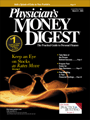Publication
Article
Physician's Money Digest
In Search of Heroes in Switzerland
Author(s):
The Golden Pass Line, the bestof the Swiss panoramictrains, rolls rapidly across theBernese Oberland towardsLucerne. It's spring, but the famed peaksare covered in snow and 1000-foot-highwaterfalls cascade in ribbons down themountains. The Alpine meadows areablaze with forsythia and apple trees inblossom, belying the suggestion thatonly Ireland has 40 shades of green. Thelittle villages are widely scattered on thesteep slopes, the farms look like skilodges, and the goats and cattle amblingacross the vista are almost cartoon-likeas they balance precariously on twoshort and two long legs. "Don't mockour cattle,"a local says. "We have themost beautiful cows in the world!"
He grins amiably and then stumps offat the next stop and strides off up amountain. It's easy to imagine what kindof people such inaccessible and difficultterrain might spawn. They'd be proud,uncomplaining, and tough with the fire ofindependence burning in their bellies.And they'd have their heroes.
Swiss Hero
American children grow up hearingabout Johnny Appleseed, British childrenhave heard the story of King Arthur, andthe whole world knows the tale ofSwitzerland's William Tell. But what reallyhappened? How much is legend?
Answers are inconclusive in Switzerland,a remote, mountainous land that hasdefied intruders throughout time. Indeed,William Tell was defying an intruder. Thetale is that around 1307, shortly after theGotthard Pass opened, Austria sent anofficial called Gessler from the HabsburgEmpire to control the Swiss town ofAltdorf. Tell, a local Swiss chamois hunter,declined to bow to Gessler's authority andwas ordered as punishment to shoot anapple from his son's head. He succeeded,but an extra arrow was hidden in his beltfor Gessler, should his first shot kill hisson. While being transported by boat toprison, he escaped by leaping to a rock atthe lake's edge. He hurried to Gessler'scastle and dispatched him with the arrow.So, bad things happen to bad people.
There are, strangely, no records of aWilliam Tell and his leadership in the subsequentrebellion that gave Switzerlandits independence. "The first mention ofhis name,"says a guide on one of LakeLucerne's paddle steamers, "is in 1472—but that rock shows the man who madehim famous in 1804."She points to theSchillerstein, a granite monolith rising 80feet high at the lake's edge. It bears thename of Friedrich Schiller, the playwrightwhose drama painted Tell as a hero.
Scenic Splendor
Beyond the picture postcard town ofBauen, at the north end of the lake, sitsAltdorf, complete with two statues ofTell. Nearby, Burglen, Tell's birthplace, ishome to the William Tell Museum, featuringa beautifully presented short filmof the William Tell legend.
The train brings you quickly toLucerne, where Americans who boughtRail Europe two-country passes beforecoming to Europe can now head forFrance, Austria, or both, depending onwhat they purchased (888-382-7245;www.raileurope.com). Lucerne itself justifies some time. It's an easy 10-minutestroll over the Reuss River, admiringLucerne's much-photographed 14th-centuryChapel Bridge. The Hotel Schweizerhof(41 41 410 0410; www.schweizerhofluzern.ch), the oldest of the city's great olddames, is just beyond, as are the architecturaldelights of a city considered to beone of the most beautiful in Europe.
